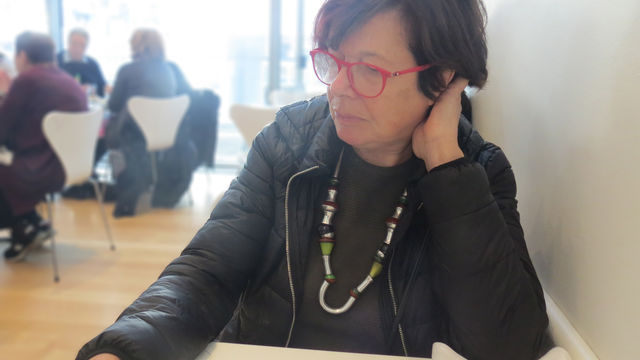
Graciela Carnevale
The Argentine artist Graciela Carnevale was born in 1942 in the town of Marcos Júarez but moved to Rosario when she was a teenager. She graduated from the Escuela de Bellas Artes, Universidad Nacional de Rosario, in 1964 and has served on its faculty since 1985. In 1965 she became involved with Grupo de Arte de Vanguardia (GAV) de Rosario, experimental artists (recent graduates of the Escuela de Bellas Artes) and other, more established artists from Rosario. Having acquired a reputation as one of the country's most dynamic avant-garde art groups, they were invited by the Museo de Arte Moderno de Buenos Aires to contribute to the group show Rosario 67. For this exhibition, Carnevale presented a sculpture titled Estructura (Structure), a work that responded to a minimalist aesthetic. In 1967 she participated in the exhibition Estructuras primarias II, presented at the Sociedad Hebráica de Buenos Aires.
In 1968 GAV made a dramatic shift when the group established Ciclo de Arte Experimental, a series of exhibitions organized every two weeks from May to October and each proposed by circle members. For her presentation, Carnevale organized Acción del encierro (Lock-up action), in which individuals attending the opening reception for the exhibition were locked in the gallery for more than an hour. Their only way to break free from the artwork was by shattering the gallery windows. A conceptual work, Acción was meant to incite violence as an art medium and also to serve as a metaphor for the growing social unrest under the de facto rule of Juan Carlos Onganía (1966–70). Again in 1968 Carnevale and GAV organized Tucumán arde (Tucumán is burning), a collective project—including research, a mass-media campaign, interviews, fliers, banners, photographs, and films—uncovering abusive operations carried out by the government in the city of Tucumán. In 1969 GAV disbanded.
Carnevale returned to the production of art in 1994, when she joined Grupo Patrimonio. Since 2003 she and the artist Mauro Machado (b. 1954) have organized the alternative space El Levante, which offers workshops and residencies for young artists in an attempt to invigorate the art scene of Rosario. Early in her career Carnevale received a grant from the Fondo Nacional de las Artes, and in 1978 she received a grant from the British Council to pursue graduate studies in London. She lives and works in Rosario. Works by GAV have been generously donated by Carnevale to the Museo de Arte Contemporáneo de Rosario, Migros Museum für Gegenwartskunst in Zurich, and other museums.
—Marcela Guerrero
Selected Exhibitions
1967 Estructuras primarias II, Sociedad Hebráica de Buenos Aires
1967 Galería Carrillo, Rosario, Argentina
1968 Acción del encierro, Rosario, Argentina
2008 Inventario, 1965–1975: Archivo Graciela Carnevale, Centro Cultural Parque de España, Rosario, Argentina
2010 Uncertain Spectator: Graciela Carnevale, Experimental Media and Performing Arts Center, Troy, NY
Selected Bibliography
Carnevale, Graciela. "Project for the Experimental Art Series, Rosario, 1968." In Participation, edited by Claire Bishop, 117–19. London: Whitechapel; Cambridge, MA: MIT Press, 2006.
Carnevale, Graciela, et al."Declaración: Encuentro de plástica latinoamericana, Casa de las Américas." Havana, 1973.
Graciela Carnevale: 7 al 19 de octubre. Rosario, Argentina, 1968.
Katzenstein, Inés, ed. Listen, Here, Now! Argentine Art of the 1960s: Writings of the Avant-Garde. New York: Museum of Modern Art, 2004.
Longoni, Ana, and Mariano Mestman. Del Di Tella a "Tucumán arde": Vanguardia artística y política en el '68 argentino. Buenos Aires: El Cielo por Asalto, 2000.


